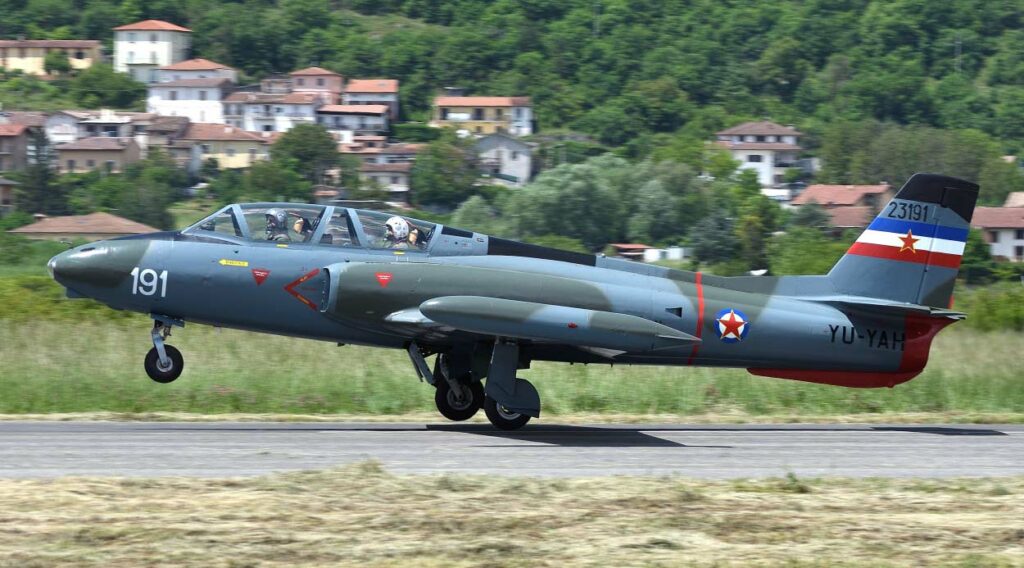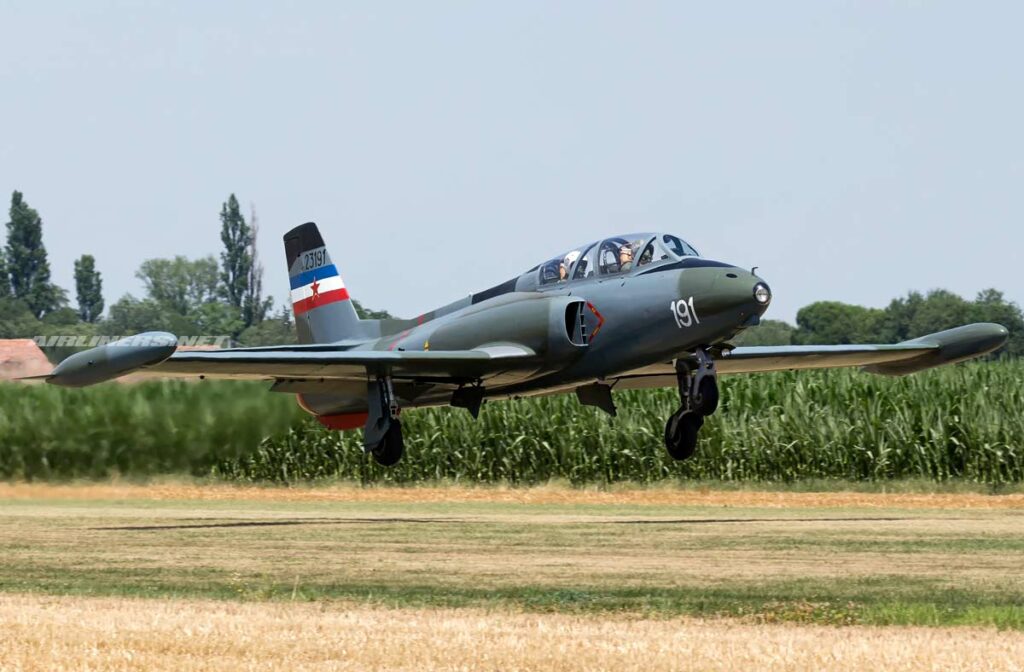The SOKO G-2 Galeb is a Yugoslav single-engine, two-seater jet trainer and light ground-attack aircraft.
In brief
The SOKO G-2 Galeb is a versatile jet aircraft, serving as both a trainer and a light attack platform. Introduced in the 1960s, it was Yugoslavia’s first indigenously designed and produced jet aircraft. Powered by a single Rolls-Royce Viper turbojet engine, the Galeb has a straightforward, durable design, suitable for both advanced flying training and ground-attack missions. It features a high-wing configuration, tandem seating, and tricycle landing gear, combining reliability with cost-effective operation. Its operational roles include primary and advanced pilot training, aerobatic performance, reconnaissance missions, and light ground-attack capabilities, illustrating its multifaceted utility in military aviation.

History of the Development of the SOKO G-2 Galeb (Seagull)
The development of the SOKO G-2 Galeb marked a significant milestone in Yugoslav aviation history, being the first domestically produced jet aircraft. In the context of the Cold War era, Yugoslavia sought to bolster its defense capabilities and reduce reliance on foreign suppliers. The G-2 Galeb, meaning “Seagull” in English, was developed to fulfill a multifunctional role, capable of advanced flight training, light attack missions, and reconnaissance duties.
The program was launched in the late 1950s by SOKO, a Yugoslav aircraft manufacturer, with the prototype’s maiden flight occurring in 1961. The design aimed to provide a cost-effective, easy-to-maintain, and versatile aircraft that could adapt to various military requirements within the Yugoslav People’s Army. Its development was driven by the need for a modern jet that could replace older piston-engine trainers and offer light combat capabilities.
While the G-2 Galeb did not receive a specific NATO nickname, its introduction represented a significant step forward for Yugoslavia’s aerospace industry, demonstrating the country’s growing technological independence during a period characterized by geopolitical tension and the global arms race.
Design of the SOKO G-2 Galeb (Seagull)
The G-2 Galeb’s design is characterized by its simplicity and functionality. The aircraft features a high-wing monoplane layout, which contributes to its stability and ease of handling, essential for its training role. It is equipped with a Rolls-Royce Viper Mk 22-6 turbojet engine, capable of producing 2,500 pounds of thrust, which ensures reliable performance and manageable running costs.
The airframe is predominantly metal, with a tandem cockpit that accommodates an instructor and a trainee, both of whom are provided with an excellent field of view, a crucial aspect for training purposes. The tricycle landing gear design facilitates easier handling on the ground and is robust enough to withstand the rigors of frequent takeoffs and landings, a common requirement for a training aircraft.
One of the notable advantages of the Galeb’s design is its straightforward maintenance, owing to its uncomplicated systems and durable construction. However, its simplicity also translates to limited avionics and weapon systems compared to more modern aircraft, which can be considered a drawback in terms of combat capability.
The G-2 was designed to be versatile, capable of performing light ground-attack missions, reconnaissance, and aerial acrobatics, in addition to its primary role as a trainer. This multi-role capability was achieved without overly complex systems, balancing performance with operational economy.
Performance of the SOKO G-2 Galeb (Seagull)
The G-2 Galeb’s performance metrics are reflective of its role as a training and light attack aircraft. Its Rolls-Royce Viper engine, while not the most powerful jet engine of its era, provides a top speed of approximately 750 km/h (466 mph) and a service ceiling of 12,000 meters (39,370 feet). The aircraft has a range of about 1,200 kilometers (746 miles), adequate for the short-range missions it was designed for.
In terms of combat power, the Galeb could be equipped with machine guns, bombs, and rockets, making it suitable for light ground-attack missions. While not comparable to high-performance fighters in terms of speed, altitude, or payload, its strength lies in its adaptability and cost-effectiveness, particularly for countries with limited defense budgets.
Comparatively, the G-2 Galeb held its own against other light attack/trainer aircraft of the time, such as the Italian Aermacchi MB-326. While it might not have matched the advanced avionics or higher speed of some contemporaries, its robustness, ease of maintenance, and versatile operational roles made it a valuable asset for the Yugoslav Air Force and other operators.
Variants of the SOKO G-2 Galeb (Seagull)
The SOKO G-2 Galeb underwent several modifications throughout its service life, resulting in various variants that enhanced its capabilities and extended its operational use:
- G-2 Galeb: The original production version, designed primarily as a jet trainer with secondary light attack capabilities. It was equipped with basic avionics and armament capabilities, suitable for training and light combat roles.
- G-2A Galeb: An upgraded variant, this version featured enhanced avionics, improved weapons systems, and increased fuel capacity, making it more effective in its light ground-attack role. It also included provisions for underwing weapons pods, expanding its ordnance carrying capabilities.
- G-2AE Galeb: This export version was tailored to the specific requirements of foreign operators, incorporating slight modifications in avionics and weapon systems based on customer needs. It retained the fundamental design and performance characteristics of the G-2A.
- NJ-22 Orao: While not a direct variant of the G-2, the NJ-22 Orao was a subsequent development that shared lineage with the Galeb, representing a more advanced jet trainer and light attack aircraft. Developed jointly by Yugoslavia and Romania, it was a testament to the evolving aerospace capabilities in the region.
These variants ensured that the G-2 Galeb remained versatile and capable of adapting to varying training and combat needs, extending its service life and operational value.

Military Use and Combat of the SOKO G-2 Galeb (Seagull)
The SOKO G-2 Galeb was extensively used by the Yugoslav Air Force and saw various degrees of action during its operational life. Its primary role was as a training aircraft, preparing pilots for transition to more advanced fighters. However, its design also allowed it to perform light attack missions, which included close air support and reconnaissance duties.
The G-2 Galeb saw combat during the Yugoslav Wars in the 1990s. It was utilized for ground-attack missions and faced a range of threats, from ground-based air defenses to potential air-to-air combat scenarios. The aircraft’s operational history during this period highlighted its robustness and adaptability in conflict zones, although it also suffered losses due to anti-aircraft fire and the challenging combat environment.
The armament of the G-2 Galeb included machine guns, bomb racks, and rocket pods, making it capable of engaging ground targets effectively. Its use in the Yugoslav Wars exemplified the aircraft’s dual-role capability, transitioning from a training to a light attack aircraft as required.
Internationally, the G-2 Galeb was exported to several countries, most notably to Libya, where it was used for pilot training as well as in light attack roles. The export versions sometimes featured modifications to suit the specific needs of the operating country, such as altered avionics suites or adapted weapon systems.
Despite the emergence of more modern training and light attack aircraft, the G-2 Galeb remained in service with some air forces into the 21st century, testament to its durability and the high regard in which it was held by its operators. However, as newer aircraft with advanced technology and improved performance characteristics became available, the G-2 was gradually phased out and replaced.
While eventually outpaced by modern aircraft with advanced technologies, the legacy of the G-2 Galeb endures as a testament to its significant contributions to pilot training and military effectiveness in multiple countries. Its enduring design principles, notably its efficiency, robustness, and versatility, continue to influence aircraft development and operational strategies in the realm of military aviation.
Back to the Trainers section.